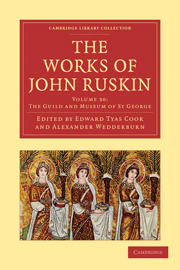Book contents
- Frontmatter
- Contents
- LIST OF ILLUSTRATIONS
- INTRODUCTION TO THIS VOLUME
- PART I THE GUILD OF ST. GEORGE
- PART II THE ST. GEORGE'S MUSEUM
- APPENDIX
- BIBLIOGRAPHICAL NOTE
- 1 LETTERS RELATING TO THE AFFAIRS OF THE ST. GEORGE'S GUILD (1875–1884)
- II LETTERS AND REPORTS RELATING TO THE ST. GEORGE'S MUSEUM (1875–1890)
- III INDUSTRIAL EXPERIMENTS IN CONNEXION WITH ST. GEORGE'S GUILD
- IV RUSKIN'S MAY QUEENS
- V THE RUSKIN CABINET AT WHITELANDS COLLEGE
- VI RUSKIN AND THE BOOKSELLERS
- Plate section
II - LETTERS AND REPORTS RELATING TO THE ST. GEORGE'S MUSEUM (1875–1890)
Published online by Cambridge University Press: 07 September 2011
- Frontmatter
- Contents
- LIST OF ILLUSTRATIONS
- INTRODUCTION TO THIS VOLUME
- PART I THE GUILD OF ST. GEORGE
- PART II THE ST. GEORGE'S MUSEUM
- APPENDIX
- BIBLIOGRAPHICAL NOTE
- 1 LETTERS RELATING TO THE AFFAIRS OF THE ST. GEORGE'S GUILD (1875–1884)
- II LETTERS AND REPORTS RELATING TO THE ST. GEORGE'S MUSEUM (1875–1890)
- III INDUSTRIAL EXPERIMENTS IN CONNEXION WITH ST. GEORGE'S GUILD
- IV RUSKIN'S MAY QUEENS
- V THE RUSKIN CABINET AT WHITELANDS COLLEGE
- VI RUSKIN AND THE BOOKSELLERS
- Plate section
Summary
[It will be remembered that Ruskin's scheme of a St. George's Museum passed through three phases. First, it was established in a small cottage at Walkley, near Sheffield. Next, it outgrew the accommodation, and the question arose, what to do with the additional objects. Ruskin declined to have them merged in any general museum at Sheffield. He proposed to build a museum of his own, either at Sheffield or elsewhere, and he had plans drawn for the building (see above, p. xlvii.). Sheffield desired not to have the museum removed, and various sites and arrangements were discussed. A solution was ultimately found when the town of Sheffield acquired the Meersbrook Park, and offered to devote the house to the purposes of a Ruskin Museum.
In this Appendix various letters and reports referring to these matters are collected.]
THE SCHEME OF ST. GEORGE'S MUSEUM: LETTER FROM RUSKIN (1875)
Brantwood, Coniston, Lancashire.
My dear Sir,—I am obliged by your note, but the work of the St. George's Company is necessarily distinct from all other. My “museum” may be perhaps nothing but a two-windowed garret. But it will have in it nothing but what deserves respect in art or admiration in nature. A great museum in the present state of the public mind is simply an exhibition of the possible modes of doing wrong in art, and an accumulation of uselessly multiplied ugliness in misunderstood nature. Our own museum at Oxford is full of distorted skulls, and your Sheffield ironwork department will necessarily contain the most barbarous abortions that human rudeness has ever produced with human fingers.
- Type
- Chapter
- Information
- The Works of John Ruskin , pp. 305 - 327Publisher: Cambridge University PressPrint publication year: 2010First published in: 1907



